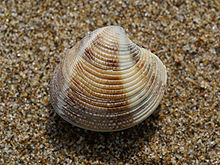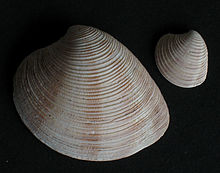- Chamelea gallina
-
Chamelea gallina 
Scientific classification Kingdom: Animalia Phylum: Mollusca Class: Bivalvia Order: Veneroida Family: Veneridae Genus: Chamelea Species: C. gallina Binomial name Chamelea gallina
Linnaeus, 1758Synonyms Venus striatula E. M. da Costa, 1778
Chamelea gallina is a species of small saltwater clam, a marine bivalve mollusc in the family Veneridae, the venus clams.[1]
Contents
Taxonomy
Linnaeus originally described Venus gallina from the Mediterranean in 1758. Other zoologists may have consequently assumed that Da Costa's 1778 Pectunculus striatulus was a different northern species. However, Linnaeus afterwards mentioned that his V. gallina also occurs in 'Oceano Norvegico'. Following Dodge in 1952, the name Chamelea gallina is considered to be valid. There are now two recognised subspecies: the Mediterranean C. g. gallina, and the Atlantic C. g. striatula.[2]
Characteristics
 Two beachworn valves of Chamelea gallina from Wales
Two beachworn valves of Chamelea gallina from Wales
The shell is solid and thick, with two equal sized valves and up to five centimetres long. It is broadly triangular but asymmetrical, having a round anterior margin but a somewhat elongated posterior. The periostracum is thin and the ligament connecting the two valves is narrow. The lunule is short and heart-shaped, light brown with fine radiating ridges. The shell is sculptured with about fifteen concentric ridges. The colour is whitish, cream or pale yellow, sometimes shiny, and usually with three red-brown radiating rays.[3]
Distribution
Chamelea gallina occurs on Eastern Atlantic coasts, from Norway and the British Isles, Portugal, Morocco, Madeira and the Canary Islands. It is also found in the Mediterranean Sea and the Black Sea and is abundant in the Adriatic Sea.[3]
Biology
Chamelea gallina lives under the surface of clean and muddy sand at a depth of between five and twenty metres. It is a filter feeder, taking in a variety of microalgae, bacteria and small particles of detritus.[3]
Uses
This species is used for food. In 1995 the total recorded catch was 42,000 tons with the largest catches being taken by Italy and Turkey. The shells are mostly caught with dredges bur some bottom trawling is done and some aquaculture takes place in Italy.[3]
References
External links
- Habiats.org.uk, images
Categories:- Veneridae
- Animals described in 1758
Wikimedia Foundation. 2010.
